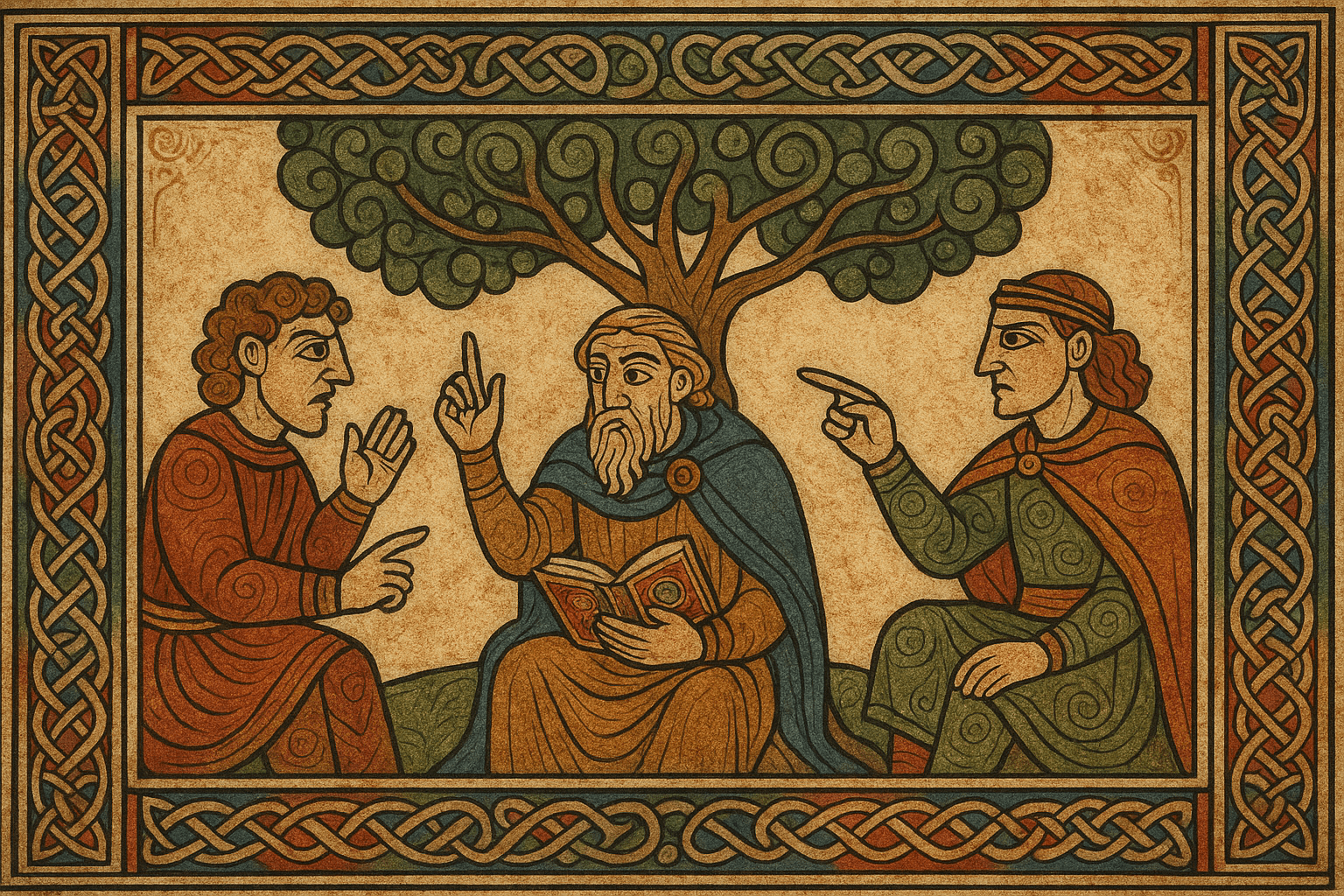The Keepers of the Law: Who Were the Brehons?
The word “Brehon” comes from the Irish breitheamh, meaning “judge.” However, these figures were far more than just judges in the modern sense. They were a professional class of jurists, arbitrators, and legal scholars who belonged to a hereditary elite. Their extensive knowledge was passed down orally through generations and taught in special law schools, where it could take over twenty years to master the vast body of legal poetry and precedent.
Crucially, a Brehon did not preside over a state-run court. Early Irish society was decentralized, organized into a patchwork of local kingdoms called túatha. When a dispute arose, the parties involved would agree to hire a Brehon to arbitrate. The Brehon would hear the case, consult the law tracts, and declare a judgment. Enforcement wasn’t his responsibility; it fell to the individuals and their kin groups to ensure the judgment was respected. To defy a Brehon’s ruling was to risk being ostracized by the community—a social death sentence in a world built on interdependence.
A System of Restitution, Not Retribution
Perhaps the most radical aspect of Brehon Law to our modern eyes is its complete rejection of punitive justice. There was no capital punishment, no state-run prisons, and no physical mutilation as punishment. The entire system was built on the principle of restitution—making things right. Every crime, from the smallest insult to the most heinous murder, was seen as an injury that created an imbalance in society. The purpose of the law was to repair that injury and restore harmony.
This was achieved through a complex system of fines. When a person was wronged, the offender was required to pay compensation to the victim or their family. For a killing, this was known as an éraic fine. This wasn’t a case of “getting away with murder” by paying a fee. It was a formal, legally mandated process designed to prevent the devastating cycle of blood feuds that plagued many other early European societies. By satisfying the victim’s family with a payment, the need for violent revenge was legally and socially extinguished.
Honour-Price and the Social Fabric
So, how was the size of a fine determined? The key was a concept called lóg n-enech, which translates to “honour-price” or “face-price.” Every free person in a túath, from the king to the farmer, had an honour-price that reflected their social status, wealth, and function within the community. This price was the measure of their social worth and legal standing.
The fine for any offense was calculated in relation to the victim’s honour-price. For example, slandering a chief would incur a much higher fine than slandering a common warrior, because the damage to the chief’s reputation was considered more significant. Likewise, the éraic fine for killing a skilled craftsman was higher than that for an unskilled laborer, reflecting the greater loss to the community. This system intricately wove the legal code into the social hierarchy, ensuring that while everyone had rights, those rights were directly tied to their place in the world.
Beyond Crime: A Law for Life
The Brehon Laws were astonishingly comprehensive, extending far beyond what we would consider criminal law today. They provided detailed regulations for contracts, property, inheritance, and social obligations, offering a fascinating glimpse into the values of Gaelic Ireland.
- Divorce Law: In an era when most of Europe considered marriage an unbreakable sacrament, Brehon Law allowed for divorce on numerous grounds for both men and women. A woman could divorce her husband for impotence, infertility, violence, or even for publicly shaming her by revealing their marital secrets. Upon separation, property was divided based on each partner’s contribution to the household, a remarkably progressive arrangement.
- Environmental Law: The laws displayed a profound respect for the natural world. There were strict fines for felling trees, which were categorized by their importance. The most valuable trees, like oak and yew, were the “Lords of the Woods”, and cutting one down illegally incurred the same fine as killing a chieftain. There were also rules governing water rights, pollution of wells, and even the liability of a beekeeper if their bees stung a passerby.
- The Duty of Hospitality: Hospitality wasn’t just a courtesy; it was a legal obligation. Households of a certain standing were required to provide food, drink, and lodging to travelers. Refusing to do so could result in a fine and severe social shame.
- Fosterage: The system of altram, or fosterage, was a key social institution regulated by law. Children were often sent to be raised in other households to strengthen kinship ties and provide them with specialized education. The laws detailed the responsibilities of foster parents and the fees they were owed.
The Decline and Legacy
The sovereignty of the Brehon Laws began to erode with the Norman invasion in the 12th century, which introduced English Common Law to the areas around Dublin known as “The Pale.” However, the native Irish system continued to be the dominant legal code across most of the island for another 400 years.
The true end came with the English Tudor conquest of the 16th and 17th centuries. The English crown viewed the Brehon system as barbaric, uncivilized, and a direct threat to its authority. It was actively suppressed and systematically replaced by English Common Law. By the mid-17th century, the ancient tradition of the Brehons had been extinguished as a functioning legal system.
Thankfully, the laws themselves were not entirely lost. Ancient manuscripts like the Senchas Már survived in monasteries and were eventually translated by scholars in the 19th century. Today, they provide an unparalleled window into the mind of a complex, pre-colonial European society. The Brehon Laws stand as a testament to a different kind of justice—one built not on punishment, but on community, honour, and the belief that even the deepest wounds can be healed.
